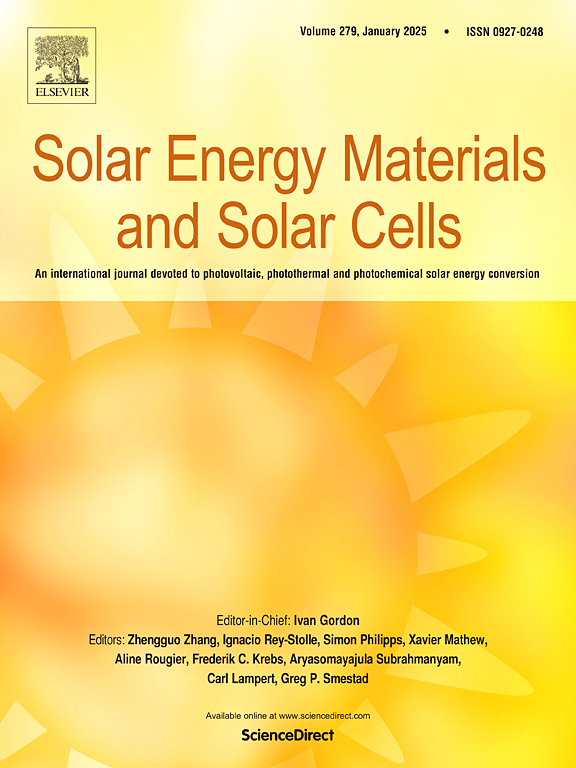Transmission electron microscopy study on the laser-cutting induced microdefects in silicon heterojunction solar cells
IF 6.3
2区 材料科学
Q2 ENERGY & FUELS
引用次数: 0
Abstract
Silicon heterojunction (SHJ) solar cells are at the forefront of high-efficiency photovoltaic (PV) technology, achieving record efficiencies and promising bifacial performance. These cells are crucial for future PV markets, but challenges like cell-to-module (CTM) losses can reduce overall module efficiency. Half-cell module technology, using thermal laser separation (TLS), helps minimize these losses, but performance degradation persists, even with edge passivation. This study investigates how TLS affects the microstructure of SHJ cells, focusing on defects formed during laser processing. We used high-resolution scanning transmission electron microscopy (STEM) to examine these changes, providing detailed insights into the cell's structure. The results reveal that the hydrogenated amorphous silicon (α-Si:H) layer near laser-cut edges crystallizes, with the affected zones spanning approximately 12 μm at the n+-n junction and 6 μm at the p+-n junction, where the crystallization patterns are influenced by laser energy. The scribing laser also melts and diffuses the indium tin oxide (ITO) layer, and induces defects in the crystalline silicon (c-Si) regions. These changes are likely the main reasons for efficiency losses, reducing cell performance. These insights are vital for developing strategies to mitigate laser-induced defects, enhancing SHJ cell efficiency and reliability for large-scale production.
硅异质结太阳能电池激光切割微缺陷的透射电镜研究
硅异质结(SHJ)太阳能电池处于高效光伏(PV)技术的前沿,实现了创纪录的效率和有前途的双面性能。这些电池对未来的光伏市场至关重要,但电池到组件(CTM)损耗等挑战会降低组件的整体效率。采用热激光分离(TLS)的半电池模块技术有助于将这些损耗降至最低,但即使采用边缘钝化,性能也会持续下降。本文研究了TLS如何影响SHJ细胞的微观结构,重点研究了激光加工过程中形成的缺陷。我们使用高分辨率扫描透射电子显微镜(STEM)来检查这些变化,提供了对细胞结构的详细见解。结果表明:靠近激光切割边缘的氢化非晶硅(α-Si:H)层发生结晶,影响区在n+-n结处约为12 μm,在p+-n结处约为6 μm,其结晶模式受激光能量的影响;刻划激光还熔化和扩散氧化铟锡(ITO)层,并在晶体硅(c-Si)区域产生缺陷。这些变化可能是效率损失的主要原因,降低了电池性能。这些见解对于制定减轻激光诱导缺陷的策略,提高SHJ电池的效率和大规模生产的可靠性至关重要。
本文章由计算机程序翻译,如有差异,请以英文原文为准。
求助全文
约1分钟内获得全文
求助全文
来源期刊

Solar Energy Materials and Solar Cells
工程技术-材料科学:综合
CiteScore
12.60
自引率
11.60%
发文量
513
审稿时长
47 days
期刊介绍:
Solar Energy Materials & Solar Cells is intended as a vehicle for the dissemination of research results on materials science and technology related to photovoltaic, photothermal and photoelectrochemical solar energy conversion. Materials science is taken in the broadest possible sense and encompasses physics, chemistry, optics, materials fabrication and analysis for all types of materials.
 求助内容:
求助内容: 应助结果提醒方式:
应助结果提醒方式:


